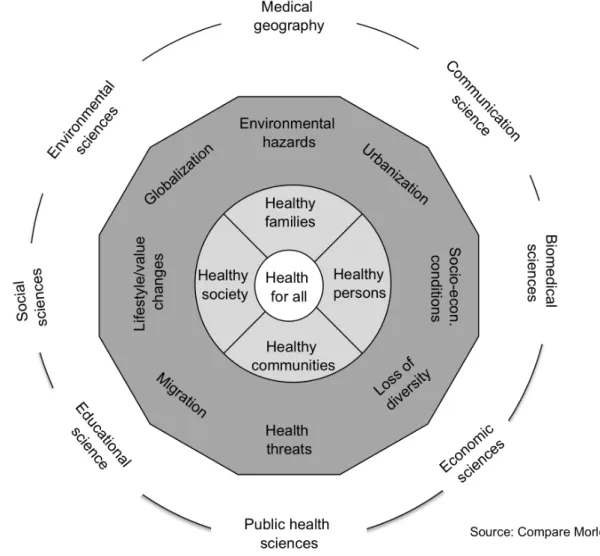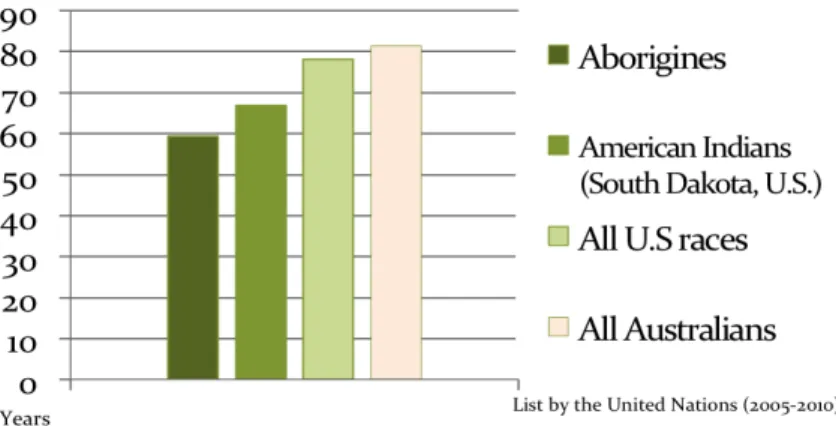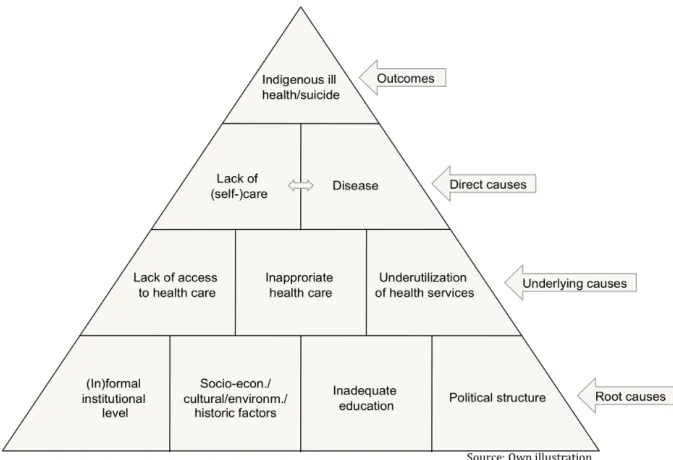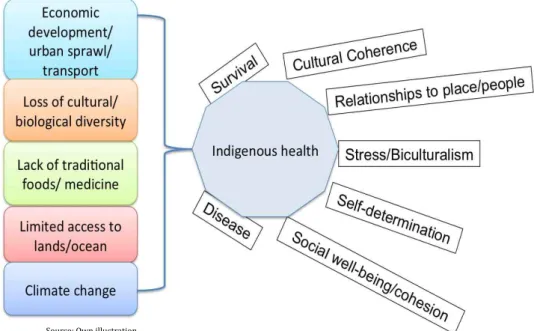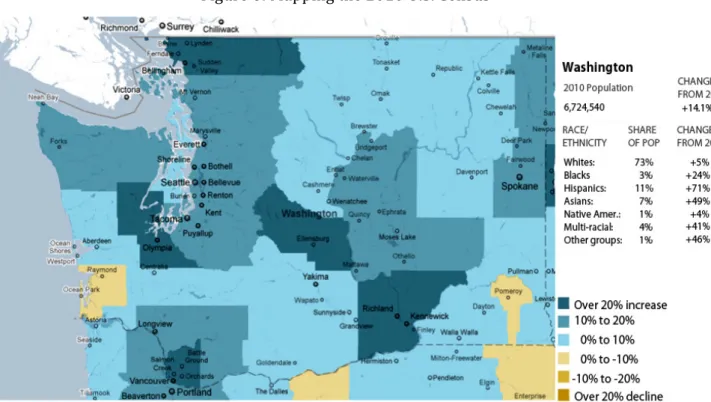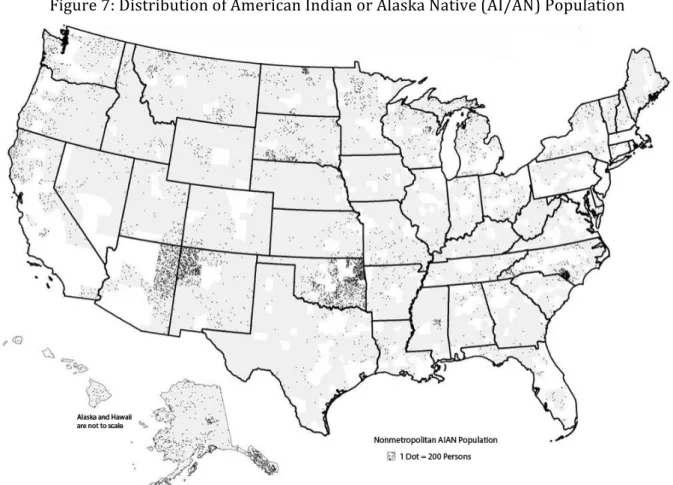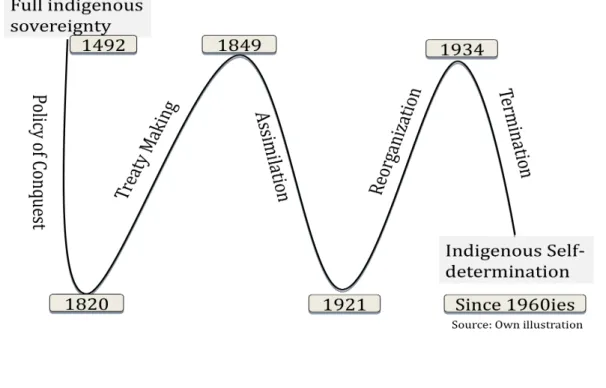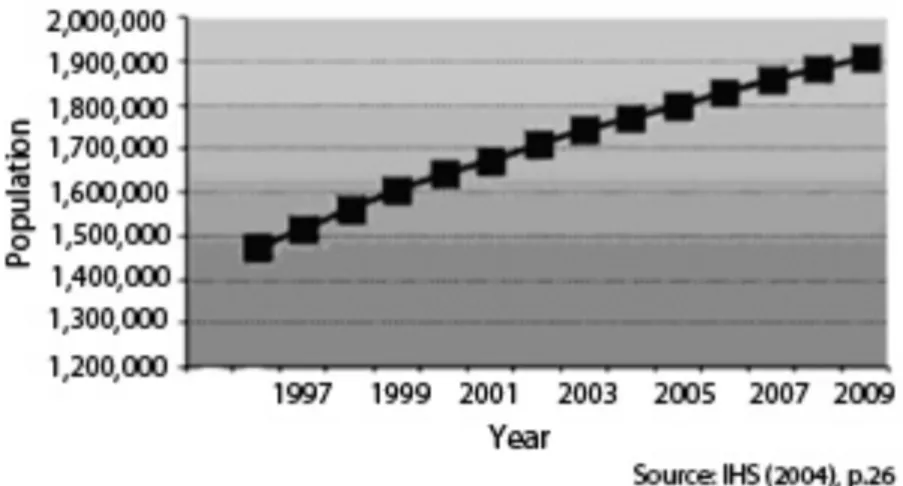Traditional Healing and Indigenous Sovereignty: Assessment and evaluation of current potential, development and deficits of Indigenous mental health care
provision in Washington State, USA
I n a u g u r a l -‐ D i s s e r t a t i o n
zur
Erlangung des Doktorgrades
der Mathematisch-‐Naturwissenschaftlichen Fakulät der Universität zu Köln
vorgelegt von
Mirjam Hirch
aus Darmstadt
Berichterstatter: Prof. Dr. Frauke Kraas
Prof. Dr. Josef Nipper
Tag der mündlichen Prüfung: 13.10.2011
Zusammenfassung
Die vorliegende Doktorarbeit erforscht aus kulturgeographischer Perspektive Bedarf und Potential selbstbestimmter Gesundheitsversorgung im Bereich psychischer Gesundheit für indigene Gemeinschaften im Bundesstaat Washington, USA.
Weltweit bestehen große gesundheitliche Disparitäten in indigenen Gemeinschaften, die zu den Gruppen mit dem schlechtesten Gesundheitsstatus zählen. Im Bereich psychischer Gesundheit haben Substanzmissbrauch und Suizid teils ein epidemisches Ausmaß erreicht.
Seit den 1960er Jahren findet das Konzept indigener Selbstbestimmung vermehrt Anwendung im Bereich indigener Gesundheitsversorgung. Eine wachsende Zahl von indigen verwalteten Gesundheitseinrichtungen bietet kultursensible Dienste an, die der effizienteren
Versorgungsleistung dienen sollen. Gleichzeitig ist im nicht-‐institutionellen Kontext das Phänomen einer wachsenden kulturellen Bewegung für bessere Lebensqualität und
Gesundheit indigener Nationen zu beobachten. Diese basiert auf der Anwendung traditionellen Wissens von ganzheitlichen Heilkonzepten.
Diese rezenten Bestrebungen werden in der Arbeit im Untersuchungsraum aus geographischer Sicht analysiert.
Das Fach Geographie wird zunehmend als zentral für ein umfassendes Gesundheitsverständnis anerkannt. Es werden vermehrt soziale Phänomene betrachtet und alternative, die Umwelt einbeziehende, Perspektiven auf Gesundheit entwickelt. Kulturelle Herangehensweisen geographischer Gesundheitsforschung an mentale Gesundheit im indigenen Kontext fehlen jedoch bislang weitestgehend. Wenige Geographen haben erforscht wie kulturelle Werte und Kosmovisionen indigene Gesundheit und Versorgungsstrukturen beeinflussen, geschweige denn die Verbindung von Identität, Ort und Gesundheit bzw. die Bedeutung “therapeutischer Landschaften” im indigenen Kontext analysiert. Hierzu möchte die Arbeit einen Beitrag leisten.
Die vorliegende qualitative Forschung kommt zu dem Ergebnis dass im Untersuchungsraum existierende selbstbestimmte, integrative Modelle, für den nachgewiesenen Bedarf, eine adäquate Versorgungsform auf institutioneller Ebene darstellen. Es wird weiterhin festgestellt dass die, auf Konzepten traditionellen Wissens basierende, kulturelle Bewegung auf
Gemeinschaftsebene zur Besserung der psychischen Befindlichkeitslage indigener Nationen
der pazifischen Nordwestküste in Washington State, USA beiträgt.
Abstract
This dissertation from a geographical perspective analyzes the need and potential of self-‐
determined Indigenous health care structures amongst Indigenous nations of Washington State, USA for the improvement of Indigenous mental health status.
Dramatic inequalities dominate Indigenous health. Mental health problems, chronic stress, substance use as well as suicide are over proportionately high within Indigenous communities who have a significantly lower life expectancy the world over. At the same time Indigenous nations are exposed to lack of health care, culturally appropriate services and oftentimes discrimination and institutional racism. Through endeavors of self-‐determination since the 1960s Indigenous nations have started to establish Indigenous health care systems to improve health care provision and lay the basis for an upward trend in their (mental) health status. At the institutional level self-‐governed clinics offer culturally sensitive services based on
Indigenous models of integrative care. At the community level public health movements have been initiated that are based on traditional knowledge and on revitalization of Indigenous cultural practices to improve health status.
There has been little research done in any discipline pertaining to the specific regional needs and types of as well as distribution of Indigenous healing services. Very few geographers have explored how cultural values and cosmovisions shape Indigenous health – not to mention the connection between place, identity and health and the importance of cultural and therapeutic landscapes in Indigenous peoples’ everyday lives. In this regard geographers possess valuable knowledge and interdisciplinary skills that can be harnessed for the analysis of comprehensive systems of health and care as a means of ensuring wider coverage of service provision
particularly to minority groups such as Indigenous peoples. Incorporating local Indigenous peoples’ perspectives of (mental) health and place the dissertation wants to contribute to the emerging field of Indigenous mental health geographies. Using mainly qualitative methods the thesis tries to ‘map’ an Indigenous cultural approach to understanding the underlying factors behind Indigenous consistent poor health and methods to eliminate health disparities.
The study comes to the conclusion that self-‐governed health care institutions can improve service provision at the institutional level. The analysis of community based health
interventions attest use of traditional medicinal knowledge to be an adequate instrument to improve psychological well-‐being among Indigenous nations in the research area.
Acknowledgements
I would like to warmly thank all the people, whose interest, presence and help allowed the realization of this thesis. The preparation of this thesis has built on several years of experience in the field of Indigenous health. I am very grateful to the many, Indigenous and non-‐
Indigenous individuals and organizations that have assisted and inspired me in this work for about 10 years and which culminated in this thesis. I regret that they are too numerous to all be mentioned individually, but special thanks are extended to the Center for World Indigenous Studies and Center for Traditional Medicine which first enabled me to work in the area of Indigenous health and traditional healing closely working with numerous nations in the Pacific Northwest of the United States, Canada and Mexico. Dr. Rÿser and Dr. Korn were a source of great encouragement and support throughout my research on the topic. Their supporting encouragement from the very beginning to attend various international conferences and workshops in order to present and discuss my work with researchers from all over the world gave me a invaluable insight into topics related to Indigenous peoples. Particularly revealing was accompanying my academic advisor Dr. Rÿser to attend the fifth session UNPFII United Nations Permanent Forum on Indigenous Issues in May 2006 at the UN Headquarters in New York. I wholeheartedly acknowledge Dr. Rÿser’s help and support during the fieldwork and writing, his valuable feedback, constant encouragement and firm support throughout.
Of the many people and agencies that have assisted in the preparation of this thesis, I extend particular thanks to the following:
Special thanks to the supervisor of this thesis Prof. Dr. Frauke Kraas who through a lecture on Indigenous peoples in 2002 at the University of Cologne ignited my strong wish to dedicate my time and energy to the Indigenous cause and then gave me the freedom to write this work in as self-‐determined a way as possible and hand it in as my dissertation. Thus enabling me to make it accessible to a broader audience. Her trust encouraged me and strengthened my will to complete the project successfully.
I would like to thank Prof. Dr. Josef Nipper very much for his willingness to review the thesis as co-‐examiner.
I am deeply grateful to my mentor Dr. Ted Mala for his transformative teachings.
I would also like to thank Gregory Twiddy for his help and support during my fieldwork.
Grateful thanks go to my sister Ellen and Dr. Ana Cangahuala.
I greatly appreciate that the German Research Foundation and DAAD -‐ German Academic Exchange Service provided me with a travel grant to support the work.
Finally I deeply thank my family, and especially my father and sister, for always encouraging
me to go my own way, and for the sympathy and appreciation they constantly showed me.
Table of Contents
Zusammenfassung ... III Abstract ...IV Acknowledgements ... V Abbreviations ... X Preface ... XIV
Part 1 Introduction ... 1
Part 2 Indigenous peoples today ...12
2.1 Indigenous health...13
2.2 Traditional healing ...20
Part 3 Methodological framework ...24
3.1 Indigenous mental health research - limitations of current research paradigms. ...24
3.2 Methodology...30
Part 4 Peoples health and place in Washington State...38
4.1 Assessment of American Indian population...38
4.2 Ethnographic basis...45
Part 5 Mainstream and Indigenous health care systems...54
5.1 The U.S. health care system...54
5.2 Pre-paid Native American health care ...57
Part 6 Mental health services for Native Americans ...67
6.1 Mental health care needs analysis...72
6.1.1 Psychology a fast growing infant...72
6.1.2 Social adversities and racial schizophrenia ...74
6.1.3 Native holocaust and postcolonial stress syndrome...77
6.2 Mental health care assessment...88
6.2.1 The availability of mental health services ...88
6.2.2 Access to mental health care and insurance...93
6.2.3 (Under)utilization of services ...100
6.2.4 Acceptability of mental health services ...102
6.2.5 Cross-‐cultural issues affecting mental health services ...106
6.3 Health program funding... 110
Part 7 “Recovery from discovery:” The need for alternative services ... 116
7.1 Self-governed Indigenous mental health care in Washington State ... 119
7.1.1 Traditional practices and CAM therapies ...124
7.1.2 Traditional medicine in the treatment of substance use...126
7.1.3 Relationship to place and people...128
7.2 Mental health and place ... 130
7.2.1 The Tribal Canoe Journey ...130
7.2.2 Dramatically changing diets ...134
7.2.3 Traditional foods and nutrition...136
7.2.4 Healthy oolichan -‐a cultural hero ...138
Part 8 Situational analysis of the traditional mental health care system ... 142
8.1 Strength of the traditional mental health care system... 142
8.1.1 Community and family support system...142
8.1.2 Therapeutic clinical landscapes ...144
8.1.3 Educational system...145
8.2 Weaknesses of the traditional mental health care system... 151
8.2.1 Lack of well defined identifiable system of practice ...151
8.2.2 Undefined management system for traditional health knowledge and programs...152
8.2.3 Lack of data, literature, scientific reports and research...154
8.2.4 Infant stage of traditional medicine training institutions and credentialing ...158
8.3 Present potential of traditional healing ... 159
8.3.1 Political acceptability -‐stakeholders are willing to engage in dialogue...160
8.3.2 More affordable type of care with a focus on prevention and promotion...167
8.4 Threats to traditional medicine practice ... 170
8.5 Safety and efficacy... 174
8.6 Policy on traditional healing and the right of self-determination... 177
Part 9 Conclusion and next steps... 184
Bibliography ... 187
Appendix A -Interview questions... 206
Appendix B- Conference activities... 209
Appendix C- Photos ... 211
Appendix D: Figures... 214
List of figures
Figure 1 Areas of Indigenous Self-‐Determination... 2
Figure 2: Integrative Collaborative Approach to Health... 7
Figure 3: Indigenous Life Expectancy ...15
Figure 4: Conceptual Framework for Causes of Indigenous Ill Health/Suicide...18
Figure 5: Indigenous Health Vulnerabilites...19
Figure 6: Mapping the 2010 U.S. Census ...39
Figure 7: Distribution of American Indian or Alaska Native (AI/AN) Population ...43
Figure 8: Policy Background -‐ Health Care for American Indians ...59
Figure 9: IHS Service Popluation...63
Figure 10: Indian Health Services Portland Area...65
Figure 11: Tribal Mental Health Services in Washington State...68
Figure 12: Vicious Cycle of Poor Mental Health and Socio-‐Economic-‐Cultural Conditions...76
Figure 13: Root Causes of Physical and Mental Distress...80
Figure 14: Factors Influencing Native Suicide...82
Figure 15: Regional Support Network (RSN) -‐ Suicide Intervention...97
Figure 16: Map of Thurston County ...99
Figure 17: Colonization Legacy not Sufficiently Considered in Mainstream System ...115
Figure 18: Mental Health Care Provision For Indigenous Nations In WA ...117
Figure 19: Framework of Indigenous Health Contexts...120
Figure 20: Locations of Certified Chemical Dependency Treatment Services...126
Figure 21: Indigenous Pathways to Optimizing Psychological Well-‐Being ...129
Figure 22: Map of Canoe Journey to Makah 2010...132
Figure 23: Salish Food Mound ...136
Figure 24: Oregon Boundary Dispute and Settlement ...138
Figure 25: Trade Routes Used by Early Settlers ...141
Figure 26: Collaboration Through Broad -‐ Based Partnerships ...162
Figure 27: Critical Indicators for Existence of Traditional Healing Knowledge ...173
Figure 28: Framework for Indigenous Health Care Systems Analysis...182
List of tables
Table 1: US Census Data 2010... 39
Table 2: Estimated 12-‐Month number of persons with serious mental illness (SMI), age 18
and older, by State, 2002... 90
Table 3: State Mental Health Agency, Mental Health Actual Dollar & Per Capita Expenditures,
2001 ... 90
Abbreviations
AA Alcoholics Anonymous
AAAHP Association of Allied Health Professionals AAMC Association of American Medical Colleges ABS Australian Bureau of Statistics
ADHD Attention Deficit Hyperactivity Disorder AI/AN American Indian/ Alaska Native
AIHC American Indian Health Commission AIVVP American Indian Vietnam Veterans Project APA American Psychological Association
APTA American Public Transportation Association AOA Administration of Aging
BIA Bureau of Indian Affairs BHR Behavioral Health Resources
CAM Complementary and Alternative Medicine
CARF Commission on Accreditation of Rehabilitation Facilities CDC Center for Disease Control and Prevention
CFR Code of Federal Regulations CHS Contract Health Services
CHSDA Contract Health Service Delivery Area CMS Centers for Medicare and Medicaid Services CTM Center for Traditional Medicine
CWIS Center for World Indigenous Studies DHHS Department of Health and Human Services DMHP Designated Mental Health Professional
DSM-‐IV Diagnostic and Statistical Manual of Mental Disorders EHMA European Health Management Organization
FTE Full-‐Time Equivalent FY Fiscal Year
GA United Nations General Assembly GOIA Governors Office of Indian Affairs HHS Health and Human Services HMO Health Maintenance Organization
HRSA Health Resources and Services Administration
HOSW Healing Our Spirit Worldwide
ICCPR International Covenant on Civil and Political Rights IHS Indian Health Service
IHCIA Indian Health Care Improvement Act IRA Indian Reorganization Act
ISDEAA Indian Self-‐Determination and Education Assistance Act I/T/U IHS Tribal Urban
JCAHO Joint Commission on Accreditation of Healthcare Organizations MAA Medical Assistance Administration
MAM Medicaid Administrative Match MHD Mental Health Division
MHSSPB Mental Health and Social Services Programs Branch MOA Memorandum of Agreement
MPO Metropolitan Planning Organization NIH National Institutes of Health
NCAIANMHR The National Center for American Indian and Alaska Native Mental Health Research NPAIHB Northwest Portland Area Indian Health Board
NSDUH National Survey on Drug Use and Health ODFW Oregon Department of Fish and Wildlife OIP Office of Indian Policy
PAHO Pan American Health Organization PHC Primary Health Care
PHS Public Health Service
PTHA Puyallup Tribal Health Authority PTSD Posttraumatic Stress Disorder RSN Regional Support Network
SAMHSA Substance Abuse and Mental Health Service Administration SED Severe Emotional Disorder
SIHB Seattle Indian Health Board SMI Serious Mental Illness
SPIPA South Puget Sound Intertribal Planning Agency
TCAM Traditional Complementary and Alternative Medicine TRPC Thurston Regional Planning Council
UNDRIP United Nations Declaration on the Rights of the Indigenous Peoples UNECOSOC United Nations Economic and Social Council
UNPFII United Nations Permanent Forum on Indigenous Issues
U.S. United States
USDA U.S. Department of Agriculture
WDFW Washington Department of Fish and Wildlife WHO World Health Organization
WIPCE World Indigenous Peoples Conference on Education
Transforming indigenous
health Outer wheel:
What is needed Inner wheel:
What is the response
Source: Own illustration according to Cris de Groot in Higgins (2005)
Preface
Over the last three decades there has been an increasing awareness of the loss of traditional medicinal knowledge. At the same time the potential of traditional healing knowledge to improve significantly the availability, access and quality of mental health and care services has been acknowledged (WHO 2001a: 4). In this regard traditional health care practitioners are seen to possess valuable and unique knowledge and skills that can be harnessed for the development of a holistic health system as a means of ensuring wider coverage of healthcare particularly to minority groups such as Indigenous people. Hence the current attempts internationally to rediscover and reinstate Indigenous traditional health systems in the most acceptable, affordable and accessible way to Indigenous peoples. Governments and
international organizations such as the World Health Organization (WHO) have been
promoting regulations and health policies that comprise the contributions made by traditional healing practices for decades. A series of questions asked in this context are: What are
examples of best practices in Indigenous healing that could serve as role models for bettering the health situation of Indigenous groups? How can possible benefits and potentially negative outcomes of these practices best be analyzed, evaluation and standardization be achieved?
What are options and efficiency of integrating or combining Indigenous healing practices and biomedical systems of care to achieve best health? So far, however, in the area of Indigenous health -‐ let alone Indigenous mental health, serious action in response to the recommendations and questions of the WHO has not been undertaken. Few studies have been conducted that enquire into these questions and investigate into local traditional practices and how these might be integrated into Indigenous health care provision (WHO 2002). Traditional healing therefore does not enjoy the status that would correspond to its significance.
The world over the health status of Indigenous peoples is deplorable. Experts working in the field of traditional healing, as expressed throughout the WHO Traditional Medicine Strategy 2002-‐2005, emphasize the need to make visible and promote the resource potential of traditional medicine in offering solutions to the contemporary problems in mental and Indigenous health. In the backdrop of this urgent need for action Indigenous nations
themselves have been taking proactive steps to find solutions to improve their health situation.
There has been significant movement in Indigenous communities to coordinate and legitimize
Indigenous concepts of health, illness and care with the mainstream health care system. First
self-‐governed clinics offer integration of services. One such Indigenous health care system, the
relationship-‐based Nuka System of Care has recently been proposed as a model for national
reform in the U.S. (TRAHANT 2010). Accordingly the emerging efforts of Indigenous self-‐
determination in health and Indigenous medicine claims on government sponsored systems to provide effective, culturally sensitive health care need to be discussed.
This paper considering historical, social cultural and legal contexts, from a geographical perspective, will give an analysis of the need and potential of Indigenous self-‐determination in mental health and care. The focus area is the Pacific Northwest Coast, particularly Washington State, USA a region which is home to some of the most political and litigious of United States’
Indigenous nations.
Choosing the topic of this thesis goes back to personal interest concerning debates on the holocaust and intergenerational trauma after WWII in my home country Germany. Key meetings with Indigenous representatives and developing friendships with members of
Indigenous groups while studying at the University College of the Cariboo in Kamloops, Canada and doing research on my Masters thesis inspired my interest in the broader topic discussed in this paper. A lecture on the UN Decade of Indigenous Peoples at the University of Cologne by the advisor of this doctoral thesis, Prof. Kraas, inspired me to do a two-‐year internship at the Center for World Indigenous Studies, Olympia, WA, USA in 2003/04. During the internship in Olympia I attended gatherings, conferences, traditional medicine seminars and meetings with the local tribes in Washington State. Through direct learning experiences and the narrated insights of my local supervisor, Dr. Rÿser, scholar of the Cowlitz nation, I could witness how the general community knowledge base and the protected knowledge (knowledge specifically owned by a family, individual or society within a tribal community) are endangered by outside forces, and by rapid changes in the interests and preferences for ideas and experiences within local cultural communities. Outside interventions have caused and forced substitution of introduced knowledge for the ancient knowledge of Indigenous societies in the Pacific Northwest. The result is that large pieces of ancient knowledge have been lost or become hidden to members of each society -‐ undermining social wellbeing and in particular undermining public and individual physical and spiritual health. It is this knowledge, in
particular the health and healing knowledge, long evolved in these cultures held to be essential
by Indigenous leaders for the restoration of social, physical and spiritual health as well as
security of the community and thus long-‐term future survival of these societies. Because of the
cultural nature of this knowledge base, virtually all application of the knowledge is dependent
on the successful transmission of knowledge from one generation to the next. Knowledge is
transmitted through the complex of relationships, languages and social organizations of life
experiences that bind diverse individuals and groups together in an area. Irrespective of any
regulations if the knowledge is not successfully transmitted, then it is effectively lost to the
ages. Confronted with this insight, the approach used in this thesis was apart from analyzing
the legal and institutional levels to focus on the activities and attitudes found within the local communities. This increased awareness of the need for community based research modalities and local community control of knowledge and local decision taking to keep or let go of that knowledge. Concerning knowledge preservation a variety of approaches was encountered.
While some nations in the U.S. might use modern technology in the form of smartphone apps for language learning technical tools to transmit knowledge used by Indigenous nations in Washington State were digital story telling besides written documentation, primarily collected and digitized in the library of the local NGO, Center for World Indigenous Studies.
The internship in Olympia and subsequent travels furthermore yielded the opportunity to learn first hand about some of the hundreds of different forms of healing found worldwide, many of them flourishing beyond the boundaries of Western medicine. I could compare and contrast various systems of health care, to see medicine's many strengths and also its weaknesses. I could observe a more holistic view of health and illness. A view that sees how illness can cause (or result from) an imbalance in the patients’ personal cosmos, particularly their connections to those around them, and how, through talk or ritual, social interventions or other treatments, this balance could be restored, psychological well-‐being achieved. This led me to an interest in traditional healing especially in the treatment of mental health issues.
Throughout the time of writing I had the chance to meet with institutions working on issues of Indigenous mental health and on the integration of traditional and Western medicine within a different paradigm of medical and cultural understanding. I had direct contact with Indigenous representatives and the opportunity to talk to some of the most respected Indigenous leaders knowledgeable in the topic with a broad range of backgrounds and fields of activism. This yielded the opportunity to find out first hand what their perspectives are about the future of local Indigenous healings and the possible combination with Western medicine. This thesis relies significantly on the qualitative input of these individual experts and healers and their professional and personal experience of the status of Indigenous mental health, local healing concepts and traditions.
Moreover attending Indigenous conferences allowed me to talk about issues seldom discussed
in most international forums. Exposed to Indigenous issues debated in the international arena I
got to understand that Indigenous peoples as practitioners of traditional medicine oftentimes
are not able to fully voice their concerns and interests concerning traditional healing and
defining of their own, cultural healing methods.
The paper calls for a new reflection on self-‐determined approaches of Indigenous mental health and mental health treatments taking into account the specific local cultural and geographical realities of the individual peoples concerned.
The research was supported through travel grants by DAAD -‐ Deutscher Akademischer
Austauschdienst (German Academic Exchange Service) and Deutsche Forschungsgemeinschaft
(German Research Foundation).
Part 1 Introduction
Dramatic inequalities dominate global health. The situation for the world’s Indigenous peoples is particularly severe. Adequate health care provision for Indigenous groups remains a major challenge the world over. Enormous disparities exist. The devastating health situation of many Indigenous groups threatens their very survival. Even within affluent countries the living and health conditions of Indigenous peoples or so-‐called fourth world nations are appalling -‐ equaling those of third world countries in some areas in the U.S. Not only does the extreme poverty many Indigenous groups live in lead to highly problematic (mental) health conditions (NCHS 2007:10). Confronted with a legacy of colonization and rapid lifestyles changes severe strain on Indigenous individuals’ and nations’ mental health is caused by these and related stress factors (GUILMET and WHITED 1989:73). Mental health problems such as inter-‐personal violence, substance abuse, and related accidental deaths and suicides are rampant in Indigenous communities and lie significantly above the national average (IWGIA 2007: 4).
Conducting a wide range of health disparities research in Indigenous communities, that is research undertaken to understand, discover and conduct studies to eliminate unjust
differences in health and health care is urgently needed to close the gaps in health status. This research has to be scientifically meritorious as well as grounded in community engagement research approaches. Due to its place based and interdisciplinary nature geography seems to lend itself ideally as a tool to Indigenous health disparities research. The discipline can offer a strength, human rights–based instead of a deficit approach to Indigenous health which
corresponds to Indigenous models of health. Geographic analysis thus could play an essential role in reversing the health disparities Indigenous communities are facing as will be further explained below.
It is more than thirty years after the landmark agreement was reached at the International Conference on Primary Health Care (PHC) in Alma Ata in 1978 by 134 Member States of the World Health Organization (WHO) gathering to adopt primary health care as the key strategy for achieving “health for all“ by the year 2000 (MAHLER 2008:747). The public policy
approach of the landmark agreement reached at Alma Ata implied a consensus on equity of distribution of important health-‐producing goods as well as services which has shaped the dynamics of public health from that time on (RAFTERY 2006: 30). Yet even though
indisputable advances have been made, the situation today remains “health for some.“
Therefore Indigenous communities have started to act themselves and find responses to their
health crisis in all sectors involved. The right of self-‐determination which they consider the
“most fundamental basis for the improvement of living and health conditions” (UNECOSOC 1996) allows Indigenous nations to re-‐establish control over their own affairs. Indigenous self-‐determination in health aims at making universally accessible to Indigenous peoples essential and affordable health care services at high quality. The concept of self-‐
determination, since the 1960s a working concept for Indigenous nations throughout the world, is not limited to health but can be found in various areas including politics, society and culture as well as science and research.
Figure 1 Areas of Indigenous Self-‐Determination
The world over Indigenous groups through endeavors of self-‐empowerment are exploring ways to actively recover land and cultural autonomy, and are consciously participating in the search for alternatives for Indigenous health (BLAISDELL 1997). Throughout the United States tribes are seeking to increasingly gain local control over health. Health care reform has recently been realized in the US. The current period is a critical time to address fundamental concerns and achieve important goals in Indigenous health. Today mainstream health care for Indigenous peoples in the U.S. can be regarded as still essentially “neocolonial,” a system that is dependent on the international relation to the U.S. -‐ for health care and health care workers.
Mainstream mental health programs and services are designed in keeping with Western views of mental health and illness embedded in a health care system with minimal focus on health promotion and disease prevention. Among those working in the U.S. mainstream health care system there is not much incentive to offer services that take into consideration the unique cultural identities, histories and sociopolitical contexts of Indigenous peoples or other minority groups. Indigenous individuals tend to avoid using mental health services provided and the medication offered by that system (MCCORMICK 1996). A high drop out rate has been reported if services are accessed and, for many Indigenous individuals, treatments are not effectual (TRIMBLE and FLEMING 1990). This puts Indigenous people “at risk of not having their mental health care needs recognized and met” (SMYE and MUSSELL 2001).
Indigenous self-‐government in institutional health care settings therefore aims at increasing cultural sensitivity to improve uptake of services. In the non-‐institutionalized community setting self-‐determination is closely linked to re-‐generating of identity. What can be observed
Self%Determination.in.
Politics. Society/Culture. Science/Research.
Indigenous*territories/**
land*claims* Relationships*to*people*and*
place* Community*Based*
Participatory*Research*
Self;government* Lifestyle/Worldview* Tribal*epistemologies*
Source:(Own(illustra1on(
in communities all along the Pacific Northwest Coast of Washington State, USA is a
phenomenon that can well be described as a ‘cultural public health movement.’ There is a resurgence of interest in traditional practices such as canoe journeys or food ceremonies among the tribes. Underlying this movement is an alternative health model with a focus on prevention and promotion of health and has Indigenous culture and peoples at its center.
Engaging in these community-‐based activities reflects a self-‐help approach that legitimizes traditional knowledge long kept underground.
With the arrival of European settlers on the North West Coast of the United States European health services were superimposed on the traditional health care system. Earlier missionaries sought to discredit traditional health practitioners, since their traditions ran counter to the belief that Western civilization was the acme of human achievement. The active participation of local communities in the healing process and prevention of illness was a possible political threat to colonial autonomy and the social control that Western medicine provided. Besides forbidding traditional medicine practices early settlers prohibited the exercise of local culture and consumption of traditional foods. Kenyan author Ngugi wa Thiong’o explains this as being part of achieving mental control through “the destruction or deliberate undervaluing of a people’s culture, their arts, dances, religions, history, geography, education, orature [oral traditions] and literature, and the conscious elevation of the language of the colonizer”
(1986:16).
Accordingly for a long time Indigenous groups of the Northwest Coast were ashamed of their
‘backwardness.’ They thought that their traditional ideas were old-‐fashioned, and tried to ignore them. The contemporary Native sovereignty, cultural and health movement in places like the Pacific Northwest can be seen as an endeavor of liberation from this legacy of colonialism and institutional racism if not ethnocide. This makes the Indigenous cause distinct from those of other ethnic minorities. Native Hawaiian activist Huanani Trask states that the Indigenous health movement reflects Indigenous peoples “actively engaged in their collective liberation” (1986:177). Trask remarks that as a decolonization movement the Indigenous health movement is “political to the core” because it functions to “unscrew the power of the colonizing force by creating a new consciousness very critical of foreign terms, foreign definitions and foreign solutions” (1999: 90). Hence Indigenous peoples’ redefining and re-‐thinking of components of their health and care systems includes finding a place for their own traditional beliefs about health and healing within the institutionalized as well as non-‐ institutionalized systems of care.
Within the contemporary health system two areas of work can be distinguished. One strand,
the other so-‐called ‘contemporary’ strand, considers illness to occur naturally and culture-‐
free. The underlying concept is based on the belief in technical solutions to problems quantified by accurate measurements. Within this strand over the course of the last few decades, mental disease has increasingly been treated by drug-‐based therapies to influence the ‘chemical imbalance.’ In contrast to this view a stance is adopted which argues, in various ways, that the key determinants of health and variations in health are intimately linked to power relations in society. Underlying causes of disease are seen as being embedded in the social, political and economic systems (KRIEGER 2001: 668). According to this strand explanations are not to be sought at the individual level alone -‐ for example, the kinds of
“unhealthy” behaviors an Indigenous person adopts. Instead it is the broader social context that matters. Therefore adherents to this view maintain that the politics of health in the context of dominant ideological understructures of social and political forms have to be analyzed more closely. Because of the stress on these macro-‐scale social, political, and economic structures, this style of approach is often also referred to as structuralist, or
alternatively as a political economy perspective (Ibid: 670). The current global resurgence of interest in traditional and alternative medicine practices on the international scene as a means of avoiding overuse of pure chemicals and achieving wider or total coverage of
healthcare for all people especially the poor, vulnerable and marginalized groups of people is in line with the structuralist perspective. The political economy perspective best corresponds to Indigenous concepts. Indigenous peoples often consider mental health issues as
synonymous with social, political and economic issues of environmental degradation, loss of land and political disenfranchisement (COHEN 1999: 26). To improve Indigenous mental health status Indigenous peoples argue not only the immediate causes of disease ought to be treated. As emphasized by the WHO Commission on Social Determinants of Health the root causes, i.e. the ‘causes of the causes’ of ill health have to be attacked (WOODMAN, GRIG et al.
2007: 13). In the Indigenous context some of the root causes are the long-‐term effects of colonization on Indigenous communities (compare figure 6 below) and the fundamental structures of social interaction. By revitalizing their traditional culture and lifestyle local Indigenous communities are testing the hypothesis that societal and cultural factors are amongst the root causes for their consistent poor health. In line with the structuralist approach psychological distress with Indigenous groups is seen to occur more as a result of geography than genes. A place-‐based approach to health therefore seems particularly relevant for Indigenous groups considering their close connection to the land. This
‘Indigenous medical geography’ bears promising potential to analyze health disparities. Yet,
there is little evidence in the discipline of geography that demonstrates understanding and
awareness of Indigenous health issues from this perspective. A sense of place and sacred
geography has been directly linked to mental and spiritual well-‐being. While more abundant for cultures in Europe and Mesoamerica research on Indigenous conceptions of sacred geography in North America is sparse (TAYLOR, KAPLAN et al. 2005: 1448).
1Very few geographers have explored how cultural belief systems, values and cosmovision (worldview that integrates the structure of space and rhythms of time) shape Indigenous health -‐ let alone the connection between place (the land) and mental health and the importance of cultural and therapeutic landscapes in Indigenous peoples’ everyday lives (WALKER 1991; Martin 2008).
The special role for ‘place’ has been recognized to represent interconnected physical,
spiritual, symbolic and social aspects and involves physical and cultural space as well as sense of place and place in the world. The medical geographer Gatell explains that places may also be thought of as ‘social settings’ or ‘social environments’ and that we are “literally
surrounded, or ‘environed’ by other people and features of the landscape” (2009: 12).
Interconnections between place, identity and health and how exactly Indigenous mental health is related to if not inseparable from issues of place has yet to be better understood.
Geographic research could aid in the process. Geography’s central role in understanding comprehensive health issues is increasingly being acknowledged (MCGIBBON 2009). Starting in the 1970s and gathering full momentum in the 1990s, medical geography has been
focusing on the influence of culture on health and the importance of place as expressed e.g.
through the movement of the ‘cultural turn’ (BONNELL, HUNT et al. 1999). In line with the endeavor of the structural approach to ‘go outside the body,’ as described previously, geography increasingly puts into focus a range of social phenomena such as mental illness, suicide and medical care (PHILO 2005: 585). An expanding but still relatively small field of inquiry is the discipline of mental health geography or geography of mental health. One impetus for the field of study emerged in the 1970s linked to so-‐called radical geography which confronted human challenges such as social inequalities. Questions were raised about oppressive relations within social structures and societies, misery and suffering, as expressed spatially. A distinct body of research has emerged since then.
2Nevertheless there is no single
1
For examples of the benefit of combining spirituality and medical practice see: Anandarajah, G., & Hight, E. (2001).
Spirituality and medical practice: Using the HOPE Questions as a practical tool for spiritual assessment. American Family Physician, 63(1), 81-‐88, http://www.aafp.org/afp/20010101/81.html. Barnes, P. M., Powell-‐Griner, E., McFann, K, & Nahin, R. L. (2004). Complementary and alternative medicine use among adults: United States, 2002. Advance Data from Vital and Health Statistics, 343. Hyattsville, Maryland: National Center for Health Statistics. Mueller, P. S., Plevak, D.
J., & Rummans, T. A. (2001). Religious involvement, spirituality, and medicine: Implications for clinical practice. Mayo Clinic Proceedings, 76(12):1225-‐35. Prayer and spirituality in health: Ancient practices, modern science. (2005).
Complementary and Alternative Medicine at the NIH Newsletter, 12(1): 1-‐4, highered.mcgraw-‐
hill.com/sites/dl/free/0072972351/230020/H03_6.pdf.
2

